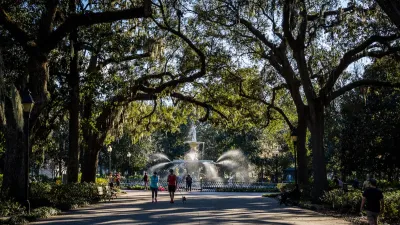Resilience science has typically been applied to ecosystems. But now, scientists are starting to look at how it relates to cities.
The theory goes that ecosystems (or places) don't respond to changes in a linear fashion, but rather they are in a constant state of flux.
"The concept of resilience upends old ideas about 'sustainability': Instead of embracing stasis, resilience emphasizes volatility, flexibility, and de-centralization. Change, from a resilience perspective, has the potential to create opportunity for development, novelty, and innovation. As Holling himself once put it, there is 'no sacred balance' in nature. 'That is a very dangerous idea.'
Over the past decade, resilience science has expanded beyond the founding group of ecologists to include economists, political scientists, mathematicians, social scientists, and archaeologists. And they have made remarkable progress in studying how habitats-including coral reefs, lakes, wetlands, forests, and irrigation systems, among others-absorb disturbance while continuing to function.
New Orleans, however, presents an interesting example to resilience scientists. If a lake can shift from clear to murky, could a city shift to a dramatically different stable state too?"
FULL STORY: Urban Resilience

Trump Administration Could Effectively End Housing Voucher Program
Federal officials are eyeing major cuts to the Section 8 program that helps millions of low-income households pay rent.

Planetizen Federal Action Tracker
A weekly monitor of how Trump’s orders and actions are impacting planners and planning in America.

The 120 Year Old Tiny Home Villages That Sheltered San Francisco’s Earthquake Refugees
More than a century ago, San Francisco mobilized to house thousands of residents displaced by the 1906 earthquake. Could their strategy offer a model for the present?

HSR Reaches Key Settlement in Northern California City
The state’s high-speed rail authority reached an agreement with Millbrae, a key city on the train’s proposed route to San Francisco.

Washington State Legislature Passes Parking Reform Bill
A bill that would limit parking requirements for new developments is headed to the governor’s desk.

Missouri Law Would Ban Protections for Housing Voucher Users
A state law seeks to overturn source-of-income discrimination bans passed by several Missouri cities.
Urban Design for Planners 1: Software Tools
This six-course series explores essential urban design concepts using open source software and equips planners with the tools they need to participate fully in the urban design process.
Planning for Universal Design
Learn the tools for implementing Universal Design in planning regulations.
Ada County Highway District
Clanton & Associates, Inc.
Jessamine County Fiscal Court
Institute for Housing and Urban Development Studies (IHS)
City of Grandview
Harvard GSD Executive Education
Toledo-Lucas County Plan Commissions
Salt Lake City
NYU Wagner Graduate School of Public Service



























